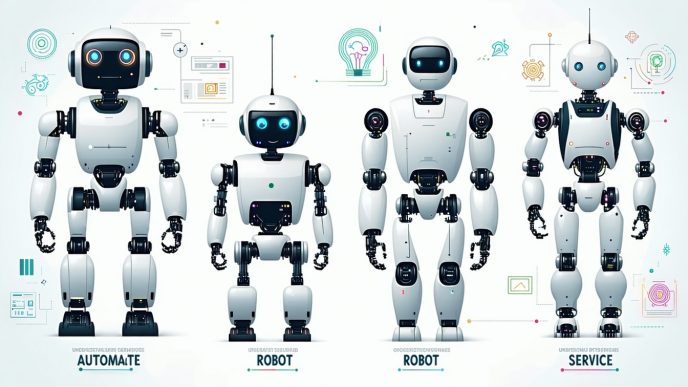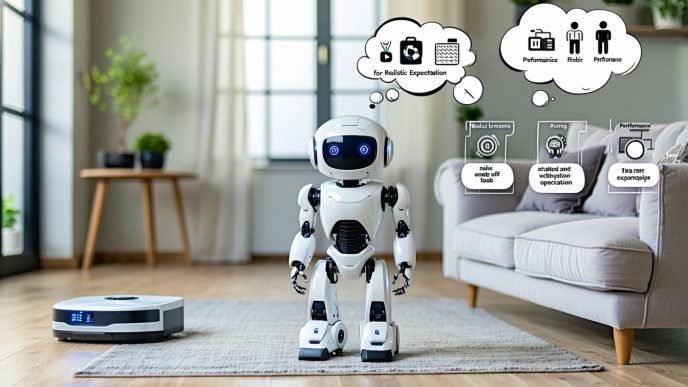Introduction to Home Robots
The Rise of Home Robotics
Home robotics has witnessed significant advancement and growth in recent years. As technology evolves, more consumers are embracing robots designed for household use. These devices range from vacuum cleaners to lawn mowers and personal assistants. The rise in the popularity of home robots can be attributed to several factors, including an increasing demand for convenience, time-saving solutions, and the pursuit of a smarter home environment.
The widespread integration of smart technologies into daily life has made home robots more accessible and user-friendly. Many families find that these robots enhance their quality of life by tackling mundane tasks and allowing them to focus on more enjoyable activities. Understanding the nuances of robot setup and the learning curves associated with these devices is crucial for potential buyers.
Benefits of Having a Home Robot
Investing in a home robot can yield numerous advantages that appeal to various households. Here are some key benefits:
| Benefit | Description |
|---|---|
| Time-saving | Robots automate repetitive tasks, such as cleaning or scheduling, freeing up valuable time. |
| Increased efficiency | Home robots often perform tasks more efficiently than humans, ensuring a thorough job. |
| Enhanced convenience | Many robots can be controlled remotely via smartphone apps, adding a layer of convenience. |
| Personalization | Users can customize settings to meet their specific needs and preferences. |
| Progress in smart homes | Home robots often integrate seamlessly with existing smart home devices, creating a cohesive home ecosystem. |
The implementation of home robotics can significantly alter household dynamics and improve overall efficiency. Prospective buyers should consider their specific needs and how a robot may enhance their lifestyle. Before making a purchasing decision, reviewing what to know before you buy a robot can provide insights into expectations and performance realities. Understanding robot types and capabilities is equally important for making an informed choice.
Types of Home Robots
As home robotics continue to gain popularity, it is essential for potential buyers to understand the different types of robots available. This section breaks down three primary categories of home robots: cleaning robots, entertainment robots, and assistant robots—each designed to serve specific roles in the household.
Cleaning Robots
Cleaning robots are among the most common home robotics, often designed to automate household chores such as vacuuming and mopping. These machines can save users considerable time and effort in maintaining a clean home.
| Type of Cleaning Robot | Common Features | Average Price Range |
|---|---|---|
| Robotic Vacuums | Automated navigation, scheduling, dustbin capacity | $200 – $1,000 |
| Robotic Mops | Wet cleaning features, multi-surface compatibility | $150 – $800 |
| Combo Units | Vacuuming and mopping capabilities | $300 – $1,500 |
When choosing a cleaning robot, it’s crucial to consider factors such as battery life, cleaning modes, and compatibility with your home environment. More details can be found in our article on what to know before you buy a robot.
Entertainment Robots
Entertainment robots are designed to provide fun and engagement for users, often featuring interactive capabilities or programmed tasks that keep the family entertained. These robots can range from simple toy-like units to sophisticated systems capable of providing personalized experiences.
| Type of Entertainment Robot | Common Features | Average Price Range |
|---|---|---|
| Robotic Pets | Interaction through movement, sounds, and light | $50 – $400 |
| Drones | Aerial photography, racing capabilities | $200 – $2,000 |
| Interactive Games | Programming capabilities, smart interface | $100 – $800 |
Understanding the range of functionalities available is important when selecting an entertainment robot for the family, ensuring it meets the desired entertainment goals. For deeper insights on robot capabilities, refer to our guide on understanding robot types and capabilities.
Assistant Robots
Assistant robots serve functional roles around the home, supporting various tasks and enhancing the smart home experience. These can range from simple voice-activated assistants to comprehensive systems that interact with other devices.
| Type of Assistant Robot | Common Features | Average Price Range |
|---|---|---|
| Voice Assistants | Voice recognition, smart home integration | $50 – $300 |
| Home Security Robots | Monitoring capabilities, mobile alerts | $150 – $750 |
| Scheduler Robots | Calendar management, reminder systems | $100 – $600 |
When selecting an assistant robot, users should consider compatibility with existing devices and the robot’s ability to integrate seamlessly into the home ecosystem. For detailed insights on compatibility and expectations, visit robot safety and home compatibility.
Knowing the differences in types can guide buyers in choosing the right home robot suited to their needs while also preparing for the necessary robot setup and learning curves. Each type offers distinct features that can greatly enhance the functionality and enjoyment of the modern home.
Factors to Consider Before Buying
Before purchasing a home robot, it is essential to evaluate several key factors that will influence its integration into daily life. Understanding these factors can guide first-time buyers and tech-savvy families in making informed decisions.
Understanding Your Needs and Expectations
Identifying specific needs and realistic expectations is crucial for any potential robot owner. Different robots serve various purposes, from cleaning to entertainment to assistance. Buyers should consider what tasks they want the robot to perform and how frequently they expect to use it.
| Purpose | Key Questions to Consider |
|---|---|
| Cleaning | Do they need it for daily maintenance or occasional use? |
| Entertainment | Are they looking for interactive features? |
| Assistance | Will it help with scheduling tasks or reminders? |
Setting sound expectations ensures satisfaction with the robot’s performance. For more insights on performance, refer to our article on realistic expectations for robot performance.
Compatibility with Other Devices
Another critical aspect is the compatibility of the robot with existing devices in the home. Many home robots can connect to smart home ecosystems, which can enhance their functionality. Checking compatibility with devices such as smartphones, smart speakers, or home security systems is essential.
| Compatibility Aspect | Considerations |
|---|---|
| Smart Home Systems | Does the robot integrate with brands like Google Nest or Amazon Alexa? |
| Mobile Applications | Can the robot be controlled via a smartphone app? |
| Additional Devices | Will it work with other tech devices already in use? |
Understanding how the robot fits into the broader smart home environment can optimize its use. More details can be found in our article on understanding robot types and capabilities.
Learning Curve and Ease of Use
The learning curve associated with setting up and using a robot varies based on the model and its features. Some robots offer user-friendly interfaces, while others may require more technical knowledge. Evaluating how easy the robot is to set up and operate can save time and frustration in the long run.
| Learning Curve Factors | Description |
|---|---|
| Setup Process | How simple is the initial setup? |
| User Interface | Is the control interface intuitive? |
| Required Technical Skills | Does it require advanced tech skills to operate? |
Choosing a robot that aligns with one’s tech-savviness is crucial for a positive experience. For further guidance, see our article on robot setup and learning curves.
Considering these factors before purchasing a home robot will pave the way for an informed decision, ensuring it meets individual needs and seamlessly fits into their lifestyle.
Setting Up Your Home Robot
Setting up a home robot can seem daunting for first-time buyers, but understanding the necessary steps can simplify the process. This section will cover unboxing and initial setup, connecting to Wi-Fi and smart home devices, and software installation and updates.
Unboxing and Initial Setup
When customers receive their home robot, the first step is the unboxing process. It is crucial to carefully unpack the robot, ensuring all accessories and manuals are accounted for. Typically, the package includes the robot itself, charging station, power adapter, and user guide.
| Item | Description |
|---|---|
| Robot | The main device that performs tasks |
| Charging Station | The base for recharging the robot’s battery |
| Power Adapter | The device that connects the charging station to a power source |
| User Guide | Instructions on setup and usage |
During the initial setup, users should place the robot in a designated area, preferably on a hard surface that allows for optimal navigation. Following the manufacturer’s guidelines is essential, as it provides necessary information regarding placement and orientation.
Connecting to Wi-Fi and Smart Home Integration
Wi-Fi connectivity is a fundamental aspect of setting up a home robot. After the initial setup, users need to connect the robot to their home Wi-Fi network. This connection allows the robot to receive updates and enables remote functionalities through mobile apps.
The following steps generally outline the Wi-Fi connection process:
- Enable Wi-Fi on the Robot: Most robots will have a dedicated button or option in the settings to turn on the Wi-Fi feature.
- Select the Network: The robot will search for available networks. Users should select their home Wi-Fi from the list.
- Enter Password: A prompt will usually ask for the Wi-Fi password to complete the connection.
Once the robot is connected to Wi-Fi, users may also explore integration with smart home systems, such as Amazon Alexa or Google Assistant. This integration enhances functionality, allowing for voice commands and automation.
Software Installation and Updates
Software installation is critical for ensuring the robot operates smoothly. Most robots come with a companion app that can be downloaded from an app store. This app typically allows users to customize settings, manage schedules, and receive important notifications.
Updates are necessary to maintain the optimal performance of the robot, addressing any bugs or enhancing features. Users should regularly check for updates within the app or the robot’s interface. Tables below provide an overview of typical software update options.
| Type of Update | Frequency | Purpose |
|---|---|---|
| Minor Updates | Monthly | Bug fixes and performance improvements |
| Major Updates | Annually | New features and capabilities |
For further information on maintaining the software of your new robot, check out our article on robot software updates and upgrades.
Understanding the aspects of robot setup and learning curves can help buyers seamlessly integrate their new devices into their homes, maximizing the benefits of automation and assistance.
Using Your Home Robot
When using a home robot, understanding its functions and commands can significantly enhance the experience. In this section, he or she will learn about essential commands, customization options, and methods to resolve common issues encountered during use.
Basic Functions and Commands
Home robots come equipped with a variety of basic functions and commands that streamline everyday tasks. Knowing these commands can facilitate smoother operation:
| Function | Description |
|---|---|
| Start Cleaning | Initiates the cleaning cycle (for cleaning robots) |
| Return Home | Sends the robot back to its docking station |
| Pause | Temporarily stops the robot’s current task |
| Resume | Continues the task after being paused |
| Schedule | Sets specific times for the robot to operate |
Familiarizing oneself with these commands aids in efficient interaction with the robot. For a detailed overview of different robot capabilities, visit understanding robot types and capabilities.
Customizing Settings and Preferences
Most home robots feature settings that can be customized to better suit individual preferences. This customization may involve adjusting the following:
| Setting | Options Available |
|---|---|
| Cleaning Modes | Standard, Turbo, Eco |
| Volume Control | Mute, Low, Medium, High |
| Language Settings | Multiple languages for voice commands |
| Scheduling | Specific days and times for operation |
Adjusting these settings can help ensure that the robot meets personalized needs. Regularly check for robot software updates and upgrades to enjoy improved functionalities.
Troubleshooting Common Issues
Home robots can sometimes experience issues. Being aware of common problems and solutions can enhance the overall experience. Some frequent issues include:
| Problem | Possible Solution |
|---|---|
| Robot not charging | Check the docking station for obstructions |
| Connectivity issues | Restart the router and reconnect the robot |
| Poor cleaning performance | Clean the brushes and sensors; check the dustbin |
| Software glitches | Perform a software reset or update |
Maintaining awareness of potential troubleshooting steps can help keep the robot functioning optimally. For details on ongoing upkeep, see robot maintenance and repair needs.
Understanding the basics of robot setup and learning curves is essential for a positive interaction with these devices. With proper knowledge of functions, customizations, and troubleshooting, users can maximize their robotic assistant’s potential in their daily lives.
Future of Home Robotics
As the landscape of home robotics continues to evolve, it is important for first-time buyers and tech enthusiasts to consider various aspects that will shape the future of these devices. This section explores advancements in AI and automation, potential integration with smart home systems, and ethical and privacy considerations surrounding home robots.
Advancements in AI and Automation
The integration of artificial intelligence (AI) in home robots is growing rapidly. These advancements enable robots to learn from user interactions and improve their functionality over time. AI allows robots to understand and adapt to individual user preferences, enhancing user experience and efficiency.
| Feature | Description |
|---|---|
| Machine Learning | Enables robots to learn from data and improve their performance. |
| Natural Language Processing | Allows robots to understand and respond to voice commands. |
| Object Recognition | Improves a robot’s ability to identify objects and navigate surroundings. |
Such advancements will significantly reduce the robot setup and learning curves for new users, making them more user-friendly. Families considering a purchase can expect robots to become increasingly intuitive and responsive to their needs. Check our article on what to know before you buy a robot for additional insights on this topic.
Potential Integration with Smart Home Ecosystem
Home robots are gradually becoming integral components of smart home ecosystems. They can connect and communicate with other smart devices, such as thermostats, security cameras, and lighting systems. This interconnectedness enhances the overall functionality of the home and provides users with seamless automation.
| Integration Type | Benefits |
|---|---|
| Home Security | Robots can work with cameras and alarms to provide comprehensive monitoring. |
| Energy Management | Robots can interact with smart thermostats to optimize energy use. |
| Convenience | Centralized control of various devices through a single interface enhances user experience. |
The ability for home robots to integrate with other technologies emphasizes the importance of robot safety and home compatibility. Users should assess their current smart home setup to maximize the benefits. For more on this subject, refer to our article on understanding robot types and capabilities.
Ethical and Privacy Considerations
As home robots become more prevalent, ethical concerns around privacy and data security arise. Many robots collect data to improve their performances, which raises questions about how this information is stored and used. Buyers must consider the implications of data collection and the potential risks associated with it.
| Consideration | Details |
|---|---|
| Data Privacy | Understand how the robot handles personal data and what measures are in place to protect it. |
| Transparency | Manufacturers should provide clear information about data usage policies. |
| User Control | Look for options that allow users to manage data collection settings. |
Awareness of these issues is crucial for first-time buyers, as it will affect their overall experience with home robotics. For further reading on related topics, see our articles on robot maintenance and repair needs and robot software updates and upgrades.















